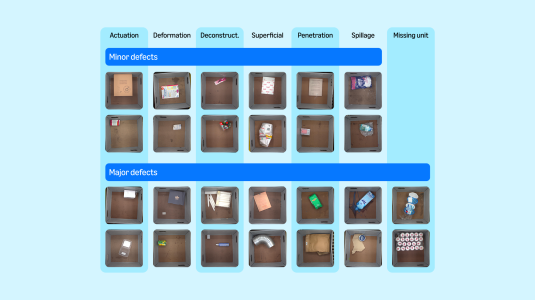Amazon delivers billions of packages each year, and for these deliveries, we aim to use as little additional packaging as possible while still ensuring products arrive safely. When additional packaging is necessary, the majority of the packaging materials we use are made from paper. This includes boxes, paper mailers, and in some cases, paper bags. One of the sustainability benefits of using paper over other packaging materials, such as conventional plastics, is that paper is generally easier to recycle for our customers. However, as with any material produced at scale today, the production processes result in carbon emissions.
The carbon emissions associated with paper packaging depend heavily on the type of paper mill, the processes and fuels used, and the grade of paper products produced. Currently, the most common type of containerboard paper mill in the US is a mixed paper mill that uses both virgin and recycled fiber. The recycled fiber generally comes from “old corrugated containers (OCC)”, which is a recycling stream that includes recycled boxes such as the Amazon boxes recycled by our customers. The virgin fiber is produced from wood chips that go through a chemical pulping process that breaks the bonds between the cellulose fibers in the wood and a glue-like substance called lignin that holds the fibers together. Containerboard paper mills that use both recycled and virgin fiber are the most common because of reduced energy demands, raw-material flexibility, cost effectiveness, and the regulatory environment.
For mills that use at least some virgin fiber to make paper, the process used to make the virgin fiber generates waste biomass that can be used as a fuel to reduce the reliance on fossil fuels. This waste biomass includes wood waste from debarking and chipping the wood and residual lignin (often called black liquor), a byproduct of the pulping process. When this waste biomass is used as a fuel for generating on-site steam and electricity, it generates what is called biogenic carbon emissions. Biogenic emissions are defined as CO2 emissions related to the natural carbon cycle, which include emissions resulting from the combustion of biological materials.
Biogenic emissions from the combustion of biomass release CO2 that was recently (in geological timeframes) sequestered by biological materials, such as plants. The US Environmental Protection Agency (EPA) does not include biogenic emissions in greenhouse gas (GHG) reporting and considers these emissions carbon neutral because of their negligible net contribution to atmospheric CO2 concentrations. This is in contrast to the carbon emissions associated with the burning of fossil fuels, which do contribute to reported GHG emissions.
In 2021, about 74% of the direct carbon emissions reported by the US pulp and paper sector were biogenic, with the remaining emissions coming from the use of fossil fuels. If these biogenic emissions are captured and permanently stored, instead of being released to the atmosphere, it enables the production of lower-carbon paper compared to traditional methods. By capturing and permanently storing biogenic carbon emissions, it is technically possible to sequester more biogenic carbon than the amount of fossil-based carbon released to the atmosphere as a result of the various industrial processes associated with paper production. This approach is generally referred to as bioenergy with carbon capture and storage (BECCS) and is considered by the Intergovernmental Panel on Climate Change (IPCC) as one of the key carbon dioxide removal technologies needed to limit global warming to 1.5°C above pre-industrial levels.

Decarbonized paper packaging
Carbon capture and storage (CCS) technology, along with sustainably managed forests, together have the potential to create a paper industry that becomes a climate solution by sequestering more emissions than the industry is responsible for releasing to the atmosphere. Although CCS technologies show promise for helping reduce or even eliminate GHG emissions, these technologies have not yet been proven out at a larger scale.
To help accelerate the development and adoption of CCS, we assembled a multi-disciplinary team to develop and propose a concept to build a CCS plant at a containerboard mill operated by one of our packaging suppliers. The proposal was one of only four selected by the Office of Clean Energy Demonstrations in the US Department of Energy (DOE). Our team includes International Paper (IP), Schlumberger (SLB) for the design and engineering, and RTI International, the research organization that originally developed the carbon capture technology. RTI took the lead on the proposal submission.
The award is for up to $88 million, and if we are able to successfully complete all stages of this first-of-its-kind project (target date 2029), this large-scale demonstration facility will capture up to 120,000 metric tons of CO2 per year, a portion of which are biogenic emissions. A CCS plant of this size can enable an annual production of approximately 100,000 metric tons of decarbonized paper that can be used for future Amazon boxes and other packaging, benefiting both our customers and the environment.

Carbon capture technologies
Carbon capture technologies absorb and separate CO2 from exhaust gases associated with combustion processes that burn fuels to generate thermal energy. There are three main approaches to how CO2 can be separated from exhaust gases: 1) pre-combustion capture, which involves absorbing the CO2 before the combustion is completed; 2) post-combustion capture, which involves absorbing the CO2 after the combustion process; and 3) oxyfuel combustion capture, which refers to burning the fuels in pure oxygen instead of air. With the oxyfuel approach, the exhaust gas is predominantly composed of CO2 and water vapor, enabling the CO2 to be easily separated. Each of these ways to absorb the CO2 varies in terms of efficacy, energy demand, and cost. The most well-developed approach is post-combustion capture.
For post-combustion capture, the CO2 can be captured by a liquid or a solid material that likes to bind to CO2. For the liquid approach, a mixture of water and 20-30% of an amine compound is typically used to bind the CO2. The process begins with putting the water-amine mixture in contact with the exhaust gases to selectively absorb the CO2 from the gas stream. After the CO2 has been absorbed, the liquid mixture is heated in a different step to release the CO2. The separated CO2 can then be compressed for storage, and the amine can be regenerated for re-use. This water-amine liquid method is known for its efficacy, but it is also relatively energy intensive. Solid materials have shown equally good adsorption of CO2, but they also require relatively high amounts of energy to adsorb and release the CO2.
Over the past 13 years, RTI International has been developing a different water-amine liquid that has much less water and more amine to address the core challenges with the traditional water-amine solutions. By significantly reducing the water content in the amine-based liquid, RTI’s non-aqueous amine solvent (NAS) carbon capture technology is able to lower the energy requirements for the absorption-regeneration cycle by up to 36% compared to the traditional water-amine liquid.
In addition to reducing energy consumption, the NAS technology also minimizes operational risks and maintenance costs due to its extremely low corrosivity and enhanced physicochemical properties. RTI’s NAS process represents a step forward for industrial decarbonization. The deployment of RTI’s NAS technology through the awarded DOE project at IP’s Vicksburg containerboard mill can help demonstrate the scalability of this promising approach to carbon capture.
Amazon co-founded the Climate Pledge with a goal to reach net-zero carbon emissions across our operations by 2040, 10 years ahead of the Paris Agreement. We recognize that achieving this ambitious goal requires partnerships across all industries to explore and develop cutting-edge carbon reduction technologies, such as CCS. This project allows Amazon to work with one of its paper packaging suppliers to scale up and demonstrate RTI’s NAS technology to decarbonize the papermaking process. This project will also serve as the foundation for de-risking and scaling this technology more broadly in the pulp and paper industry and across other sectors, such as cement and steel.





















